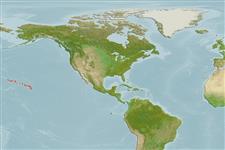>
Ovalentaria/misc (Various families in series Ovalentaria) >
Pomacentridae (Damselfishes) > Chrominae
Etymology: Dascyllus: Greek, daskillys, -on = a kind of fish (Ref. 45335).
More on author: Gill.
Environment: milieu / climate zone / depth range / distribution range
Ecologia
marino associati a barriera corallina; non migratori; distribuzione batimetrica 1 - 50 m (Ref. 7247). Tropical; 30°N - 15°N
Eastern Central Pacific: Hawaiian Islands and Johnston Island.
Size / Peso / Age
Maturity: Lm ? range ? - ? cm
Max length : 13.0 cm TL maschio/sesso non determinato; (Ref. 9710)
Spine dorsali (totale): 12; Raggi dorsali molli (totale): 15-16; Spine anali 2; Raggi anali molli: 15 - 16. Closely related D. trimaculatus, which does not occur in the Hawaiian Islands and Johnston Island.
Adults are found in very shallow, protected water, over coral and rocky bottoms. Young often sheltering among the branches of Pocillopora; occasionally commensal with the anemone Marcanthia cookei (Ref. 9710). Benthopelagic (Ref. 58302). Peak spawning from May to August. Age-at-maturity estimated at one year. Feed on zooplankton, benthic invertebrates, and algae (Ref. 9710). Oviparous, distinct pairing during breeding (Ref. 205). Eggs are demersal and adhere to the substrate (Ref. 205). Males guard and aerate the eggs (Ref. 205). Have been reared in captivity (Ref. 35412).
Life cycle and mating behavior
Maturità | Riproduzione | Deposizione | Uova | Fecundity | Larve
Oviparous, distinct pairing during breeding (Ref. 205). Eggs are demersal and adhere to the substrate (Ref. 205). Males guard and aerate the eggs (Ref. 205). While protogyny was originally proposed for this species, recent studies confirmed gonochorism in the form of non-functional hermaphroditism (Ref. 103751).
Allen, G.R., 1991. Damselfishes of the world. Mergus Publishers, Melle, Germany. 271 p. (Ref. 7247)
IUCN Red List Status (Ref. 130435)
Threat to humans
Harmless
Human uses
Acquario: Commerciale
Informazioni ulteriori
BibliografiaAcquacolturaProfilo di acquacolturaVarietàGeneticaElectrophoresesEreditarietàMalattieElaborazioneNutrientsMass conversion
Strumenti
Special reports
Download XML
Fonti Internet
Estimates based on models
Preferred temperature (Ref.
123201): 24.2 - 25.9, mean 25.1 °C (based on 57 cells).
Phylogenetic diversity index (Ref.
82804): PD
50 = 0.5005 [Uniqueness, from 0.5 = low to 2.0 = high].
Bayesian length-weight: a=0.02089 (0.00940 - 0.04644), b=2.98 (2.80 - 3.16), in cm total length, based on LWR estimates for this (Sub)family-body shape (Ref.
93245).
Trophic level (Ref.
69278): 3.1 ±0.3 se; based on diet studies.
Resilienza (Ref.
120179): Alto, tempo minimo di raddoppiamento della popolazione meno di 15 mesi (Preliminary K or Fecundity.).
Fishing Vulnerability (Ref.
59153): Low vulnerability (10 of 100).
Nutrients (Ref.
124155): Calcium = 131 [68, 222] mg/100g; Iron = 1.15 [0.65, 1.98] mg/100g; Protein = 18.3 [17.0, 19.5] %; Omega3 = 0.119 [0.065, 0.219] g/100g; Selenium = 40 [19, 83] μg/100g; VitaminA = 62.9 [18.1, 229.5] μg/100g; Zinc = 1.67 [1.07, 2.47] mg/100g (wet weight);
